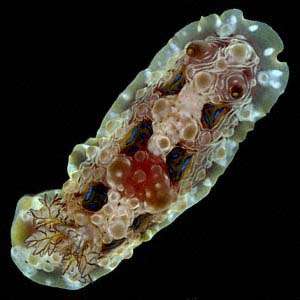
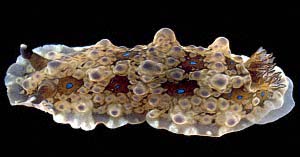
Dendrodoris denisoni
(Angas, 1864)
Order: NUDIBRANCHIA
Suborder: DORIDINA
Family: Dendrodorididae
DISTRIBUTION
Tropical and warm temperate Indo-West Pacific.
PHOTO
UPPER: Koumac, northern New Caledonia, October 1993, 18mm long alive. PHOTO: Bill Rudman.
LOWER: Port Stephens, New South Wales, Sept 1980 PHOTO: H.McLennan.
Dendrodoris denisoni is a widespread common species throughout the Indo-West Pacific. Not surprisingly it has been given a number of different names including Dendrodoris gemmacea (Alder & Hancock, 1864), which is commonly used for this species in New Zealand. Alder & Hancock's name was published a matter of months after Angas's D. denisoni so the latter has priority. Other names which are probably synonyms include Doridopsis clavulata Alder & Hancock, 1864, Doridopsis mammosa Abraham, 1877 and Dendrodoris arenosa Risbec. Another name, Dendrodoris gunnamatta Allan, 1932 probably applies to a darker colour form found in coastal New South Wales in which the blue spots are very small or absent. I will post a picture of this colour form when I get time.
Reference:
• Angas, G.F. (1864). Description d'espèces nouvelles appartenant à plusieurs genres de Mollusques Nudibranches des environs de Port-Jackson (Nouvelles-Galles du Sud), accompagnée de dessins faits d'après nature. Journal de Conchyliologie, 12: 43-70.
Rudman, W.B., 1998 (December 13) Dendrodoris denisoni (Angas, 1864). [In] Sea Slug Forum. Australian Museum, Sydney. Available from http://www.seaslugforum.net/find/denddeni
Related messages
Re: Dendrodoris denisoni or D. gunnamatta
November 12, 2009
From: Atkinson, L. & D.
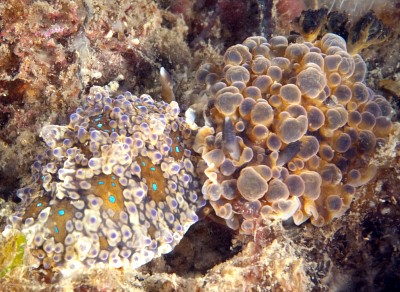
Concerning message #2588:
Hi Bill,
David found these Dendrodoris mating. One is our typical Dendrodoris denisoni and the other is the less commonly seen colour form that is sometimes referred to as Dendrodoris gunnamatta. We thought these photos of them mating might add to the discussion as to whether they are distinct species or just different colour forms of the same species. The sea had been quite stirred up with the northeast wind and several dive schools had been through so there is a bit of sand over them and we didn't clean them up because we didn't want to disturb.
Locality: Fly Point, Port Stephens-Great Lakes Marine Park, Port Stephens , 8 metres, New South Wales, Australia, Pacific Ocean, 08 November 2009, Sandy silty bottom with sponges, ascidians, gorgonias, soft corals, hydroids and seaweed. Length: approximately 80 mm. Photographer: Leanne and David Atkinson.
Regards
Leanne & David Atkinson
atk@hunterlink.net.au
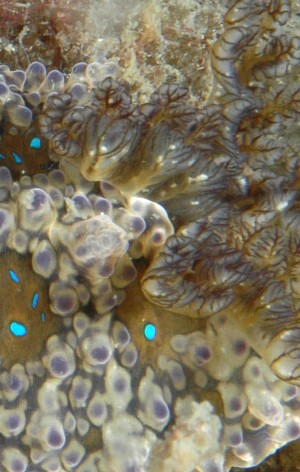
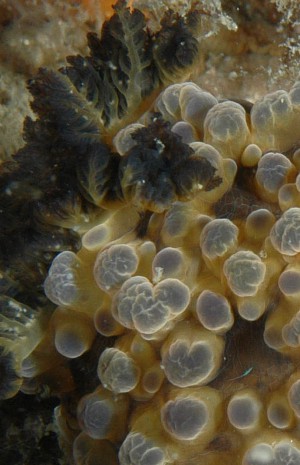
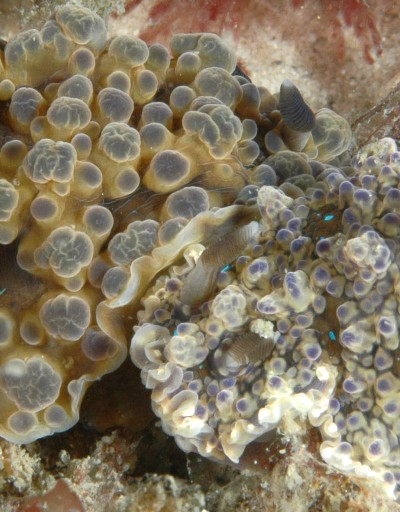
Dear Leanne and David,
Thanks for these interesting photos. As I have discussed elswehere on this page I have always considered D. gunnamatta to be a colour form of D. denisoni but short of DNA studies there is little anatomically to help differentiate them. I guess mating is the supreme DNA test so thanks again! I guess we should wait until fertile offspring are produced but I tend to believe the view that physical and/or behavioural barriers to mating have evolved between related species.
It is interesting that both names refer to animals from Sydney - D. denisoni from the cleaner waters of Sydney Harbour and D. gunnamatta from the sheltered, muddy waters of Gunnamatta Bay, Port Hacking.
Best wishes,
Bill Rudman
A species of Halgerda?
August 18, 2009
From: Nick Chapman
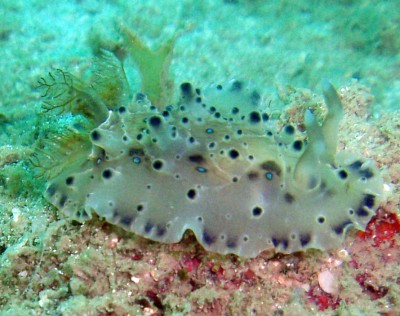
Concerning message #21917:
Hello Bill,
Are there any Halgerda sp reported with the black pustules shown on this beast? Please excuse my stupidity if it's not a Halgerda!
Locality: Chaloklum Bay, 6 metres, Koh Phangan, Thailand, Gulf of Thailand, 03 June 2009, Sand, rocks. Length: ~3 cm. Photographer: Nick.
Thank you again & Best wishes,
Nick.
info@chaloklum-diving.com
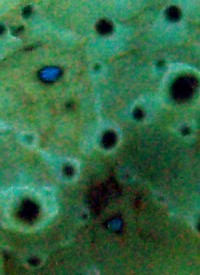
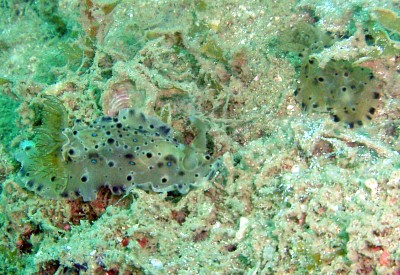
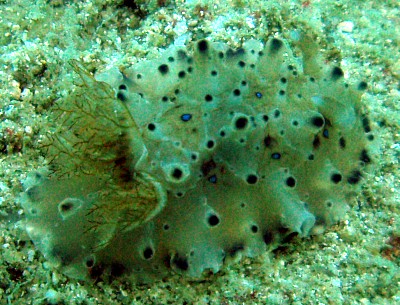
Dear Nick,
It certainly has the general appearance of some species of Halgerda, so please don't think of yourself as stupid, but it is one of the many forms of Dendrodoris denisoni. The blue spots are a good clue. Also, this species has a very thin body-wall, so if you touch it you would find it is much softer than a species of Halgerda, which has a thick muscular, somewhat rigid, body-wall.
Best wishes,
Bill Rudman
Re: Dendrodoris denisoni from Sydney
August 1, 2008
From: Jessica Herder
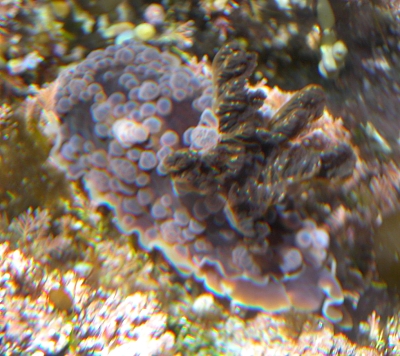
Concerning message #1711:
Dear Bill,
In your response to Stephanie Clark's message you mentioned that the colour form of Dendrodoris denisoni often refered to as D. gunnamatta is common in estuaries and large harbours and you had not seen this colour form on the open coast.
On the 19 July 2008 I saw the specimen in the attached photos in an ocean bath (rock pool) at Bulgo (southern end of Royal National Park, southern fringe of Sydney).The man-made ocean bath is situated in the intertidal zone being fed by the high tide from the open ocean.
Locality: Bulgo, Royal National Park, 1-2 m (approx), NSW, Australia, south pacific ocean, Tasman Sea, 19 July 2008, Intertidal. Length: 100 mm (approx). Photographer: Jessica Herder.
Jessica Herder
herderj@gmail.com
Herder, J.L., 2008 (Aug 1) Re: Dendrodoris denisoni from Sydney. [Message in] Sea Slug Forum. Australian Museum, Sydney. Available from http://www.seaslugforum.net/find/21751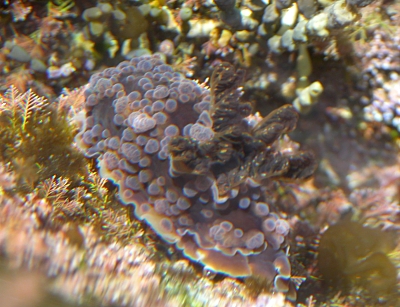
Dear Jess,
Thanks for the record. As I discuss in another message [#2588], we still have a lot to learn about the animals I have grouped together as D. denisoni, so every little bit of information counts.
Best wishes,
Bill Rudman
Dendrodoris denisoni from South Africa
April 11, 2008
From: Peter Small
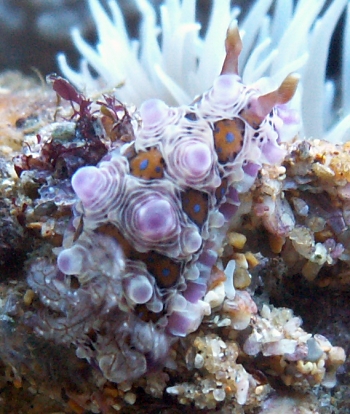
Hi
I am new to the forum, and discovered this magnificent little guy in a rock pool off the Umkomaas Beach, south of Durban, South Africa. I have tried all available references, but cannot find it. Can you help?
Locality: Umkomaas Beach, south of Durban, KwaZulu Natal, 1 m, South Africa, Indian Ocean, 04 April 2008, Intertidal rocky pool. Length: 12 mm. Photographer: Peter Small.
Regards
Peter
peters@mut.ac.za
Small, C.P., 2008 (Apr 11) Dendrodoris denisoni from South Africa. [Message in] Sea Slug Forum. Australian Museum, Sydney. Available from http://www.seaslugforum.net/find/21509Dear Peter,
This is a juvenile Dendrodoris denisoni. It is quite variable in colour and often the juveniles are more brightly coloured than the adults.
Best wishes,
Bill Rudman
Dendrodoris denisoni from Rockingham WA
August 13, 2007
From: Mick Tait
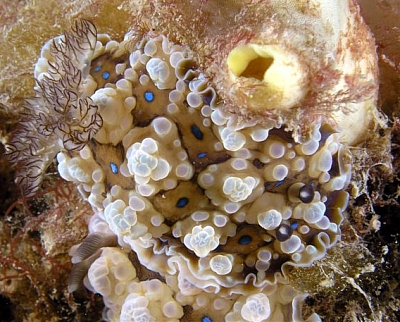
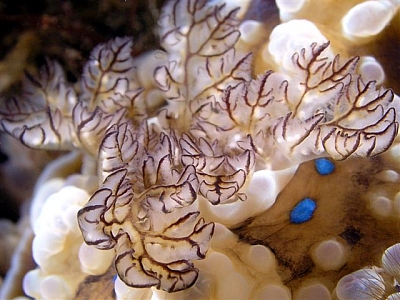
Photos taken at the Rockingham Wreck Trail south of Perth, Western Australia
Locality: Rockingham, 12 metres, WA, Australia, Cockburn Sound, 07 July 07, Sandy Bottom. Length: 35 mm. Photographer: Mick Tait.
Mick Tait
mick@bluesphere.com.au
Tait. M., 2007 (Aug 13) Dendrodoris denisoni from Rockingham WA. [Message in] Sea Slug Forum. Australian Museum, Sydney. Available from http://www.seaslugforum.net/find/20383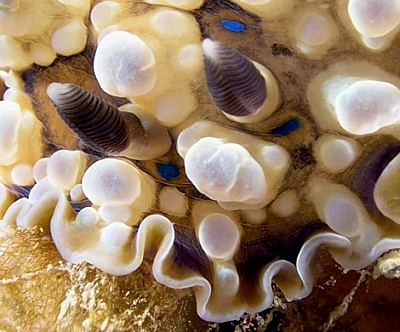
Thanks Mick,
Bill Rudman
Another Dendrodoris denisoni from Thailand
April 13, 2007
From: Mr Philip Mason
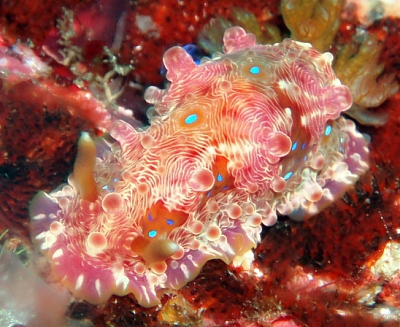
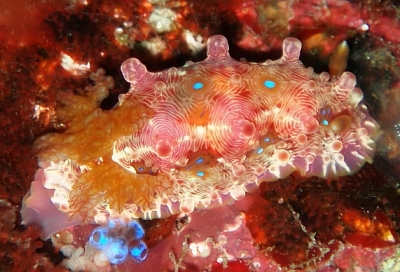
Can you help me identifiy this very pretty little critter? I can find nothing like it any of the books I have checked.
Locality: Similan Islands, 10m, Thailand, Andaman Sea, Jan 29th 07, Prmoinant rocks in fringing coral reef.. Length: 5 cm. Photographer: Philip Mason.
Philip Mason.
philipmason69@hotmail.com
Mason, P.J., 2007 (Apr 13) Another Dendrodoris denisoni from Thailand. [Message in] Sea Slug Forum. Australian Museum, Sydney. Available from http://www.seaslugforum.net/find/19640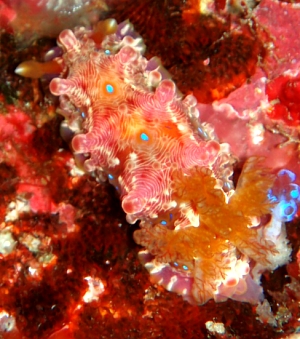
Dear Fil,
Since you sent this message and your last [message #19641] at the same time you won't have seen my comment about the blue spots. This beautiful specimen is also Dendrodoris denisoni. Smaller animals often have a reddish or pinkish background colour like this, and often the tubercles on the back are more prominent.
Best wishes,
Bill Rudman
Dendrodoris denisoni from Thailand
April 12, 2007
From: Mr Philip Mason
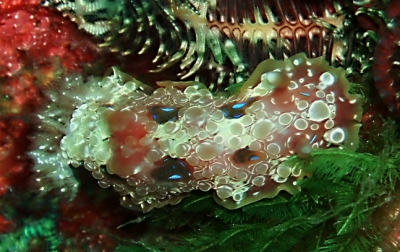
Here is another strange Nudi I found clinging to Richellieu Rock in the shallow surge zone. I apologise for the poor quality of the images, this is a difficult location to shoot.
I can find nothing like this in any books. Can you help me identify it?
Locality: Richellieu Rock, Surin National Park, 3m, Thailand, Andaman Sea, March 1st 07, Rocky (granite) intertidial surge-zone. Length: 6cm. Photographer: Philip Mason.
Philip Mason
philipmason69@hotmail.com
Mason, P.J., 2007 (Apr 12) Dendrodoris denisoni from Thailand. [Message in] Sea Slug Forum. Australian Museum, Sydney. Available from http://www.seaslugforum.net/find/19641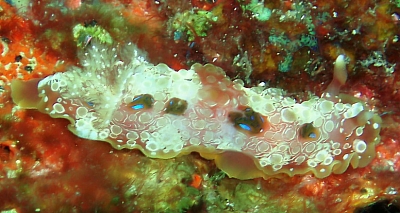
Dear Fil,
This is Dendrodoris denisoni. It is quite variable in colour, but the blue spots are pretty characteristic.
Best wishes,
Bill Rudman
Dendrodoris denisoni from Townsville, Queensland
December 12, 2006
From: Melanie Wood
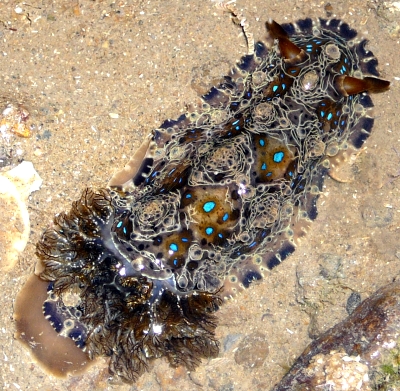
Hi,
I found this lovely nudibranch, Dendrodoris denisoni, at Rowes Bay, Townsville, Queensland. It was out under the full moon at 2 am, 05 December 2006. Additionally, I saw three more in the same general area (low tide and exposed). This is the first time I have personally seen this one in this area and fell in love with it!
Locality: Rowes Bay, Townsville, Low tide, exposed, Queensland, Australia, 05 December 2006, Intertidal . Length: Approximately 4 inches . Photographer: Melanie Wood.
Just wanted to share.
Thanks
Melanie
melanie.wood@jcu.edu.au
Wood, M., 2006 (Dec 12) Dendrodoris denisoni from Townsville, Queensland. [Message in] Sea Slug Forum. Australian Museum, Sydney. Available from http://www.seaslugforum.net/find/18940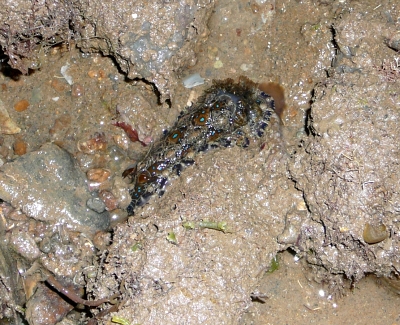
Dear Melanie,
It is indeed a beautiful animal. As you show in the photo alongside, species of Dendrodoris are often found in muddy 'ecological slums' like this. I guess the sponges they feed on are able to live in these less than pristine conditions. Many nudibranchs emerge only at night to escape hungry fish, but in intertidal regions like this, emerging at night is the only time these shell-less slugs can hope to survive the drying effects of the heat.
Any time you have observations, and animals, to share, your messages will be welcome.
Best wishes,
Bill Rudman
Bizarre behavior of Dendrodoris denisoni
June 23, 2006
From: Dong Bum Koh
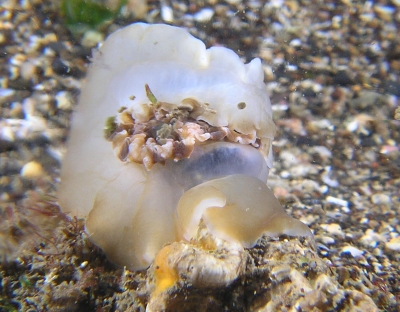
Dear Bill,
We observed this bizarre behavior of Dendrodoris denisoni during night diving in Jeju island. When we found it the mantle seemed fully inside out, and it only slowly returned to its original posture.
Locality: Hwa Soon , 4m, Jeju Is.. Korea, Pacific, 19 Dec.2004, Sandy. Length: Approx.35mm. Photographer: Sang Yul Shin.
Could you let me know the meanings of behavior?
Best regards,
Dong Bum Koh
drkoh@seasee.co.kr
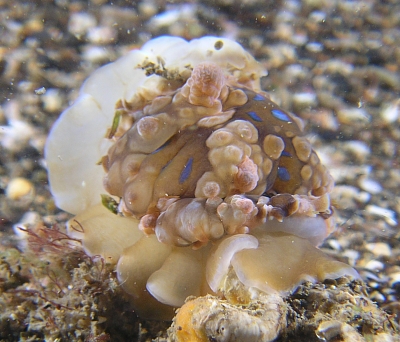
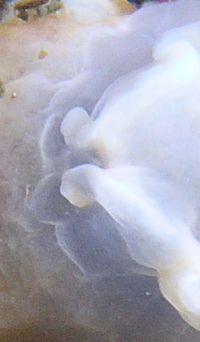
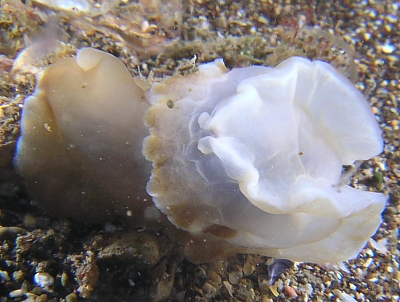
Dear Koh,
I have seen this behaviour in some dendrodorids when I have been trying to preserve them, but not in the field. As I discuss on the Preservation Fact Sheet, most nudibranchs need to be narcotised or 'put to sleep' before they are preserved, otherwise their muscles contract and they become a shapeless ball which is impossible to dissect. Animals without a solid skeleton to which the muscles can be attached, use the fluid in their body cavity to keep their general shape, but when unnatural contractions occur, the blood can be forced into strange places, and so result in strange shapes. Dendrodorids like D. denisoni seem to have little elasticity in their mantle skin - in fact the mantle seems to lack a muscle layer, so when the mantle contracts, the fluid is forced into the more elastic foot which results in the look you have described and illustrated.
I am not sure why it has happened 'in the wild', but it is possible that the Dendrodoris has been 'mouthed' by a fish and then spat out. Fish often take potential prey into their mouth for testing before chewing or swallowing, and it is possible a fish found it distasteful and spat it out, but in the process digestive or salivary secretions may have irritated its mantle. Another possibility, which I have seen in aquarium situations, is that the slug has come into contact with the feeding tentacles of a sea anemone, and this is its reponse to being stung.
Whatever the reason, some good has come of the situation, because you have taken an excellent photo of a dendrodorid head [see close-up photo], which is quite different from the head of most other dorids [see Dorid head Fact Sheet ]. Dendrodorids do not have a 'snout' or a pair of oral tentacles. They have a pair of flaps which run from the foot up on each side of the mouth to form a little 'box' around the pore-like mouth. Dendrodorids do not have any radular teeth, so they feed by secreting digestive juices out on to the sponge they are feeding on. The sponge tissue is then half digested into a 'sponge soup' which the dorid can then suck in. However, this can't take place in the open sea or the juices would be quickly diluted by the surrounding sea water. Unfortunately we can't actually see what's happening when they are feeding, but I think these flaps are there to form a seal around the mouth and the sponge, to enclose the digestive processes which are occurring outside the body.
Best wishes,
Bill Rudman
Dendrodoris denisoni from Bali, Indonesia
May 28, 2005
From: Stefan Harrieder
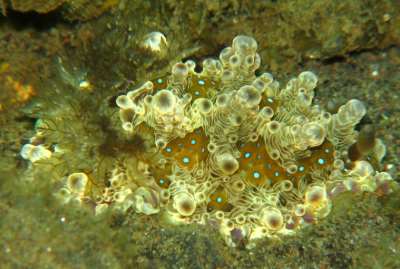
Dear Bill,
ve found a nice nudibranch in Tulamben, Bali, but I'm not quite sure if it is Ceratosoma miamirana (small blue spots on the back). Can you help me to identify this nudibranch? Thank you in advance.
Locality: Tulamben, Bali, Indonesia, Bali Sea. Depth: 11 metres. Length: 60 mm.14 May 2005. Volcano sand. Photographer: Stefan Harrieder
Stefan
sharrieder@t-online.de
Harrieder, S., 2005 (May 28) Dendrodoris denisoni from Bali, Indonesia. [Message in] Sea Slug Forum. Australian Museum, Sydney. Available from http://www.seaslugforum.net/find/13852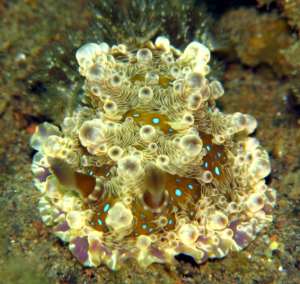
Dear Stefan,
Blue spots unfortunately are not unique to Ceratosoma miamirana. Your animal is Dendrodoris denisoni, a widespread species, found throughout the Indo-West Pacific.
Best wishes,
Bill Rudman
The eggs of Dendrodoris denisoni in S. Korea
May 10, 2005
From: Dong Bum Koh
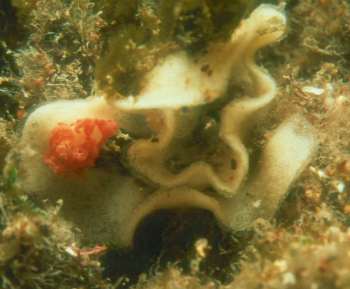
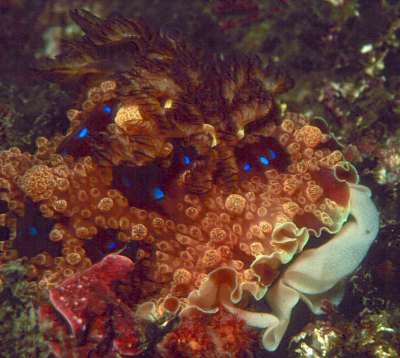
Dear Bill,
To accompany my photos of Favorinus japonicus feeding on the egg band of Dendrodoris denisoni [#13709], here is a photo of D. denisoni laying an egg ribbon. In my prior message (#13700) the eggs are also from D. denisoni.
Locality: Hwa Soon, South Korea. Pacific. Depth: 4 m. 28 Nov. 2004. Sandy bottom with Rock Wall. Photographer: Dong Bum Koh
Best regards,
Dong Bum Koh
drkoh@seasee.co.kr
Koh, D. B. , 2005 (May 10) The eggs of Dendrodoris denisoni in S. Korea. [Message in] Sea Slug Forum. Australian Museum, Sydney. Available from http://www.seaslugforum.net/find/13680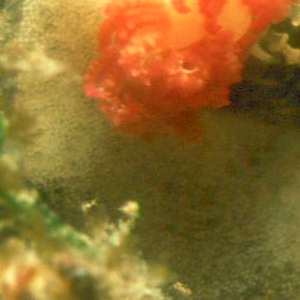
Dear Koh,
This is a valuable photo as it shows the small eggs, characteristic of a species with planktotrophic larvae. There is some suggestion that some colour forms of Dendrodoris denisoni may be separate species, so it is good to build up information on the nature of their eggs and egg ribbons.
Best wishes,
Bill Rudman
Dendrodoris denisoni from Singapore
April 22, 2005
From: Lim Han Peng
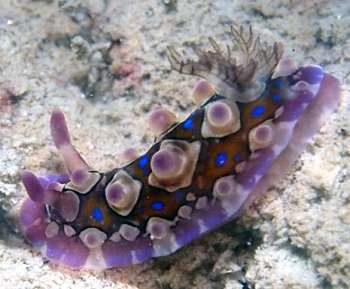
Hi Bill,
Found this nice little gem at Pulau Hantu, Singapore. Thinking you might be interested to know about it.
Locality: Pulau Hantu, Singapore, South China Sea. Depth: 10 m. Length: 15 mm. 26 March 2005. Sandy bottom. Photographer: H.P. Lim
lp
limhp@hotpop.com
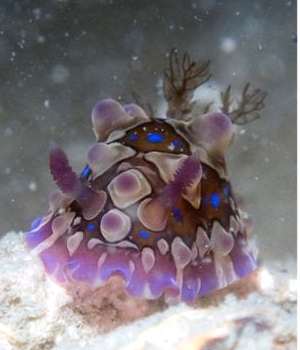
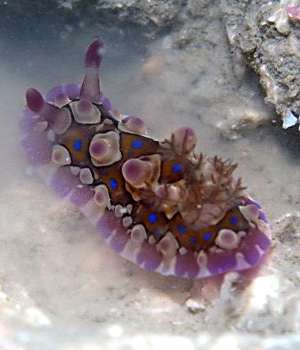
Dear hp,
One of the other names which have been given to Dendrodoris denisoni is D. gemmacea, so your not alone in thinking of it as a 'gem' - especially when it is small.
Best wishes,
Bill Rudman
Dendrodoris denisoni from Reunion island
February 22, 2005
From: Philibert Bidgrain
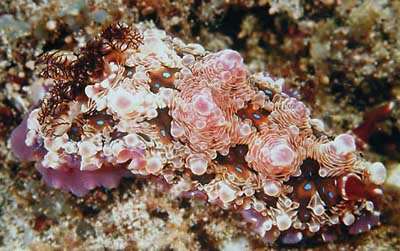
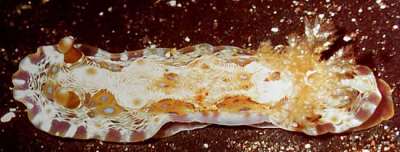
Dear Bill,
Reunion Island sea slugs.
We have only two specimens of Dendrodoris denisoni, observed by Maurice Jay, a few years ago. The lower one was found in "Pointe des galets" Harbour, 3 m, 30 November 1986. Photographer: Maurice Jay
Best Regards
Philibert Bidgrain
http://vieoceane.free.fr/runseaslug/indexslug.htm
pbidgrain@yahoo.fr
Bidgrain, P., 2005 (Feb 22) Dendrodoris denisoni from Reunion island. [Message in] Sea Slug Forum. Australian Museum, Sydney. Available from http://www.seaslugforum.net/find/13003Thanks Philibert,
Bill Rudman
Dendrodoris denisoni from Northern NSW
March 15, 2004
From: Denis Riek
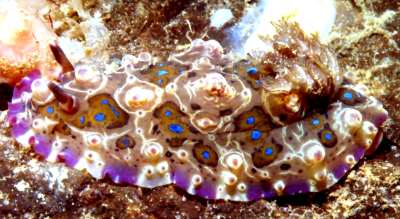
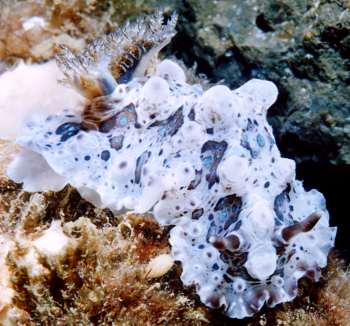
Dear Bill,
Dendrodoris denisoni was one of the more frequently encountered species in the Brunswick River [nthn New South Wales, Australia] around Nov-Dec 2003. Always seen on the top of the tide as the current stopped and always on the move, over rock, weed and sand. All were coloured similar to the first photo, from juveniles to adults 70-80mm. The one in the second photo measured approx 55mm and was the only one in this colour.
Regards,
Denis Riek
denisriek@hotmail.com
Riek, D., 2004 (Mar 15) Dendrodoris denisoni from Northern NSW. [Message in] Sea Slug Forum. Australian Museum, Sydney. Available from http://www.seaslugforum.net/find/12430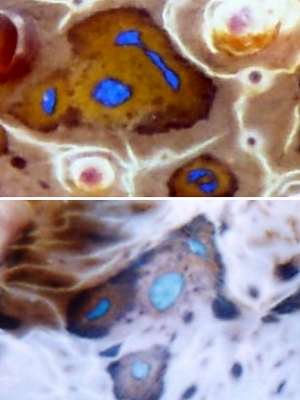
Thanks Denis,
It is unusualy from ralatively large animals to be as brightly coloured as in your upper photo, and I must say I don'rt recall seeing one quite as pale as in your lower photo. They both however show the brownish patches between the tubercules, and the blue spots
Best wishes
Bill Rudman
Dendrodoris denisoni from New Zealand
January 8, 2004
From: Mark Burnett
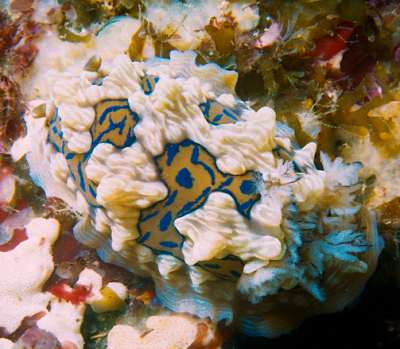
Hello Bill,
Here is the picture of Dendrodoris denisoni from the Rainbow Warrior [Bay of Islands, nthn New Zealand]. It is such a variable animal in colour, even in the same location, but this one seems to be trying to mimic Tambja verconis with its yellow and blue (not a serious suggestion of course!). This animal was around 7cm long and was sitting on one of the pieces of wreckage that have fallen off the Warrior and are lying on the sand at 26 metres. As for my other message the temperature was 16 deg C and the photo was taken on 17th December 2003.
Best regards
Mark Burnett
mburnett@actrix.gen.nz
Burnett, M., 2004 (Jan 8) Dendrodoris denisoni from New Zealand. [Message in] Sea Slug Forum. Australian Museum, Sydney. Available from http://www.seaslugforum.net/find/11827Thanks Mark,
Bill Rudman
Dendrodoris denisoni from Thailand
July 11, 2003
From: Nat Yisunsri
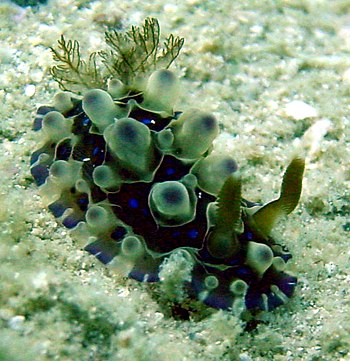
Dear Sir,
I came across your website while browsing through the internet.
The attached picture of this nudibranch was taken at the following location:
Koh Sak (Near to Pattaya Beach), Thailand
Date: 6th April, 2003
Camera: Sony Cybershot P-5, Housing MPK-5
Detail: F = 3.5
Exposure = 1/320 s
Macro Lens = 2x + 3x
Please kindly advice the above species as I would like to keep the detail of this nudibranch. I look forward to learn the feedback from you soon.
Best regards,
Nat Yisunsri
nat@terminalasia.com
Yisunsri, N., 2003 (Jul 11) Dendrodoris denisoni from Thailand. [Message in] Sea Slug Forum. Australian Museum, Sydney. Available from http://www.seaslugforum.net/find/9985Dear Nat,
This is Dendrodoris denisoni. It is quite variable in colour and is found throughout the Indian and tropical Pacific Oceans. It is also found in the cooler temperate waters of South Africa and New Zealand.
Best wishes,
Bill Rudman
Dendrodoris denisoni from Indonesia
May 23, 2003
From: Tony White
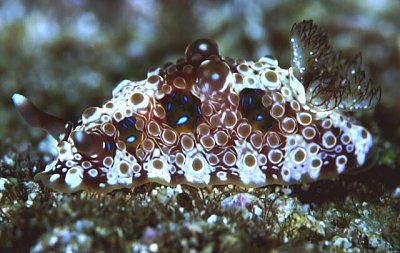
Hi,
I was diving off Pura in the Lesser Sundra Island group of Indonesia early afternoon on the 13-03-03 in approx 6 metres of water. Bottom was made up of coral outcrops interspersed with a sandy bottom. The enclosed image shows the subject which was approx 25mm long with nodules all over his skin, and very active. We very much would appreciate your opinion on this subject as so far we have been unable to identify it.
Tony White
London, UK.
seaofdreams@btinternet.com
White, T., 2003 (May 23) Dendrodoris denisoni from Indonesia. [Message in] Sea Slug Forum. Australian Museum, Sydney. Available from http://www.seaslugforum.net/find/9755Dear Tony,
This is Dendrodoris denisoni. It is found throughout the tropical Indo-West Pacific region and also extends into the temperate fringes of this great faunal region.
Best wishes,
Bill Rudman
Dendrodoris denisoni and starfish
February 21, 2003
From: Dong Bum, Koh
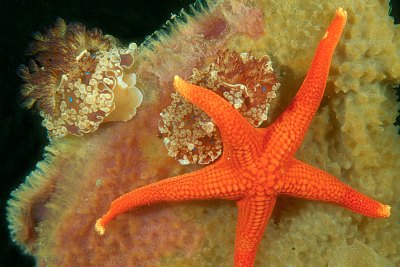
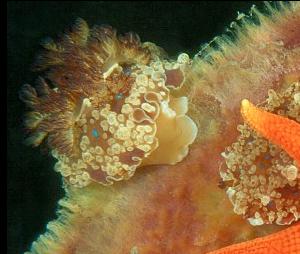
Dear Bill,
Here is a photo of Dendrodoris denisoni with a starfish.
I took this picture in October 2001, depth 13m in Moon islet, Cheju Is., S. Korea during daytime.
Could you tell me about the meaning of this scene?
Best regards,
From Dong Bum, Koh
drkoh@seasee.co.kr
Koh, D.B., 2003 (Feb 21) Dendrodoris denisoni and starfish. [Message in] Sea Slug Forum. Australian Museum, Sydney. Available from http://www.seaslugforum.net/find/9211Dear Dong Bum,
Thanks for the interesting photo. It looks like the two Dendrodoris are on a sponge colony, which has overgrown perhaps a bivalve? It might be an interesting clue to which sponges D. denisoni feeds on. I guess you are also interested in the starfish. It certainly looks as though it is about to crawl over the Dendrodoris, but I couldn't say whether this means it is interested in eating the slug, or whether it just means the slug is in the starfish's way. I am afraid we have very little information on what eats sea slugs. I think one species of starfish has been reported eating small sea hares in New Zealand, but apart from that I couldn't say whether starfish find opisthobranchs palatable.
Best wishes,
Bill Rudman
Dendrodoris denisoni from New Zealand
February 21, 2003
From: Mark Burnett
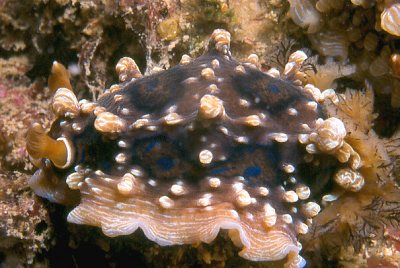
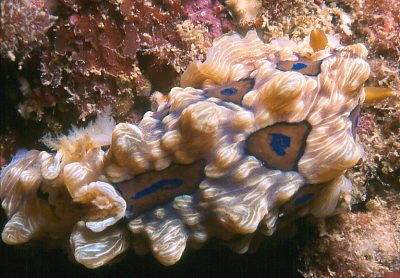
Hi Bill,
On a recent dive on a reef near a group of small islands known as the Noises in the Hauraki Gulf, [northeastern New Zealand] I came across large numbers of nudibranchs. The vast majority were Ceratosoma amoena (see separate message) but there were also many Dendrodoris denisoni. The size and colour ranges were quite marked and I have included pictures of two examples. The depth range was between 7 and 20 metres and the habitat sponge and kelp covered rock. The animal in the upper photo was approx 7cm long, and the one in the second photo, 10cm. There were larger examples which would not fit into my framer (1:2). I also saw a few Aphelodoris luctuosa but I was unable to get decent shots.
Mark Burnett
mburnett@actrix.gen.nz
Burnett, M., 2003 (Feb 21) Dendrodoris denisoni from New Zealand. [Message in] Sea Slug Forum. Australian Museum, Sydney. Available from http://www.seaslugforum.net/find/9212Thanks Mark,
Ii is good to get photos showing this sort of variation. This species is very widespread in both the tropical and more temperate Indo-West Pacific and shows considerable colour variation. By coincidence I am also posting a message today about this species from South Korea. It would certainly be an interesting exercise to compare the DNA of specimens from all parts of its geographic range. Without a radula, or clear anatomcal differences, there is no other way to test whether Dendrodoris denisoni is indeed one species or a complex of many species.
Best wishes,
Bill Rudman
Dendrodoris denisoni from Chek Jawa, Singapore
January 30, 2003
From: Ria Tan
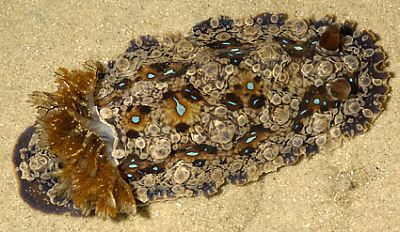
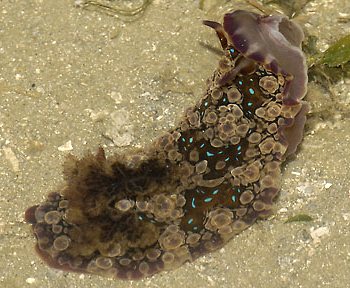
Dear Bill,
Here ia another animal from the intertidal flat at Chek Jawa, Singapore. Photo: Alan Yeo
Best wishes,
Ria Tan
tanria@singnet.com.sg
Tan, R., 2003 (Jan 30) Dendrodoris denisoni from Chek Jawa, Singapore. [Message in] Sea Slug Forum. Australian Museum, Sydney. Available from http://www.seaslugforum.net/find/9046Dear Ria,
This is another sponge-feeding dorid nudibranch, Dendrodoris denisoni. Species of Dendrodoris lack the special teeth [or radula] found in most sponge-feeding dorids and feed by releasing digestive juices out of their mouth so that the nearby sponge dissolves into a 'soup' which can then be sucked into their mouths.
Best wishes,
Bill Rudman
Dendrodoris denisoni from Port Stephens
January 17, 2003
From: Allan Saben
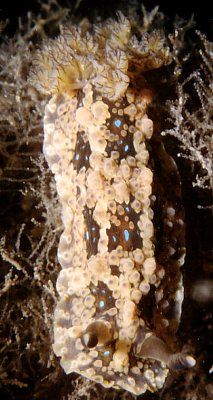
Hi Bill,
Here is a photo of Dendrodoris denisoni from Nelson Bay, Port Stephens [Halifax and Flypoint divesites, New South Wales, Australia, December 2002].
Enjoy,
Allan Saben
asaben@bigpond.net.au
Saben, A., 2003 (Jan 17) Dendrodoris denisoni from Port Stephens. [Message in] Sea Slug Forum. Australian Museum, Sydney. Available from http://www.seaslugforum.net/find/8869Thanks Allan,
Bill Rudman
Dendrodoris denisoni from New Zealand
December 12, 2002
From: Ian Simpson
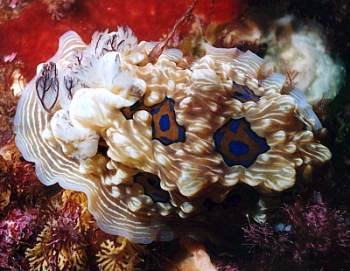
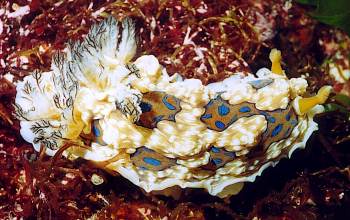
Dear Bill,
Here is Dendrodoris denisoni from Poor Knights Islands, northeastern New Zealand, 8th November 2001; 10 metres.
In these photos the specimens appear slightly different to any you have on your website. I have also spotted, on one occasion only, D. denisoni at Bare Island in Sydney (5 Jan, 2002). I mention this because there do not appear to be many sightings this far south. As an aside, I have always found this species in 'shallow depths' of around 5-10 metres. Is this typical, and if so, is this because it's food source is only found in shallow depths?
Ian Simpson
barts computer@hotmail.com
Simpson, I., 2002 (Dec 12) Dendrodoris denisoni from New Zealand. [Message in] Sea Slug Forum. Australian Museum, Sydney. Available from http://www.seaslugforum.net/find/8602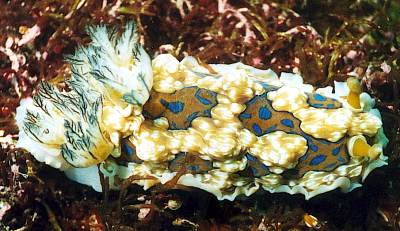
Thanks Ian,
This is the common colour form in New Zealand. Most species of Dendrodoris seem to occur from the intertidal down to varying depths. I doubt if there are any good studies recording their distribution depth limits, and we still have much to learn about their food preferences, so I really can't answer your question about whether their food preferences restrict their depth distribution
best wishes
Bill Rudman
Dendrodoris denisoni from Taiwan
August 15, 2002
From: Connie
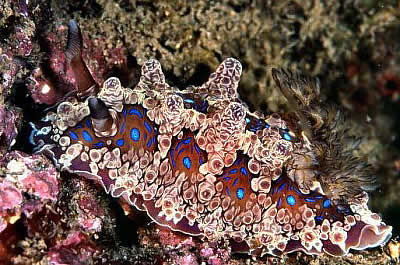
Hello Bill,
My friend and I found this beautiful nudibranch on a shore dive. Could you help us to identify these animals?
Locality: The Northeast coast, Taiwan
Depth: 8-10m
Date: August 3, 2002
Best Regards
Connie
connie.chen8d@msa.com.tw
Connie, 2002 (Aug 15) Dendrodoris denisoni from Taiwan. [Message in] Sea Slug Forum. Australian Museum, Sydney. Available from http://www.seaslugforum.net/find/7769Dear Connie,
This is a particularly colourful example of Dendrodoris denisoni.
Best wishes,
Bill Rudman
Dendrodoris denisoni from Hawaii
July 16, 2002
From: Rita Bishop
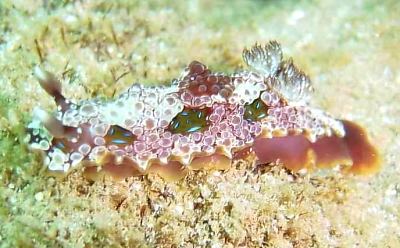
Hello..
This photo was taken at Northshore, Hawaii on July 7, 2002. Iit was taken by Dr Glenn Poulain and sent to me for help in identification. I'm at a loss. It was taken on a flat, coral bottom at approx. 30ft, water temp was 78 degrees.. any help with be appreciated .. thanks so much for your help!!
Aloha
Rita Bishop
usdiver97@aol.com
Bishop, R., 2002 (Jul 16) Dendrodoris denisoni from Hawaii. [Message in] Sea Slug Forum. Australian Museum, Sydney. Available from http://www.seaslugforum.net/find/7480Dear Rita,
This is one of the colour forms of Dendrodoris denisoni. The blue patches are fairly indicative of this species.
Best wishes,
Bill Rudman
Hoplodoris?? from the Philippines
November 14, 2001
From: Erwin Köhler
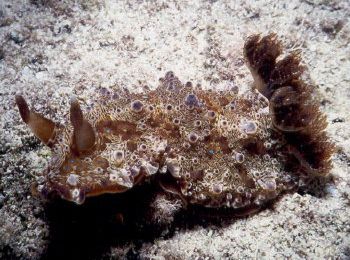
Hi Bill,
Attached is a photo by Johny Leffelaer
johny.leffelaer@pandora.be
It is from Moalboal, Cebu Is., Philippines.
I think it looks like Hoplodoris sp. or something like that.
Erwin
Erwin@medslugs.de
Köhler, E., 2001 (Nov 14) Hoplodoris?? from the Philippines. [Message in] Sea Slug Forum. Australian Museum, Sydney. Available from http://www.seaslugforum.net/find/5656Dear Erwin,
It is a form of Dendrodoris denisoni. If you see a photo of an animal with very swollen rhinophore stalks and disproportionately large gills, like in this photo, you can be pretty sure it is a species of Dendrodoris. This doesn't mean that their rhinophore stalks always look swollen and their gills disproportionately large, but I don't know of other dorids that ever look like this.
Best wishes,
Bill Rudman
Behaviour of Dendrodoris denisoni in New Zealand
September 24, 2001
From: Liz Buckley
Hi,
I am a student at the Bay of Plenty Polytechnic in New Zealand, and am studying the nudibranchs in the area. I currently have 9 Dendrodoris denisoni (Gem Nudibranch) in my tank, and am studying their social behaviour. I have encountered something a bit strange, and am wondering if anyone one can shed some light on this for me: I observed two nudibranchs nose to tail in the mating position on the 17 September in one corner of the tank, the next day, they had moved around the tank to the other side and were joined by a juvenille. By late afternoon yesterday, there were seven of them in a group, with two pairs mating. Today, all 9 of them are concentrated in one area, and seem to be huddled together. My question is two fold: Is this ordinary mating behaviour, and if they are mating how long before the lay the eggs? If they are not mating, is there something wrong in the tank? They have a huge variety of food ranging from sponges to algae, and do seem to be eating properly. The ph, ammonia, nitrite and nitrate levels are all fine and have not changed since they were put in to the tank over a week ago.
If you are able to help in anyway that would be fantastic!
Kind regards
Liz Buckley
Tauranga
nudibranchchick@hotmail.com
Buckley, L., 2001 (Sep 24) Behaviour of Dendrodoris denisoni in New Zealand. [Message in] Sea Slug Forum. Australian Museum, Sydney. Available from http://www.seaslugforum.net/find/5311Dear Liz,
I am afraid there is little known about the biology of this species. All I can say is that it will feed on a sponge, but what species I am not sure. I think it lays a white typical dorid egg ribbon and has very small eggs which hatch into planktonic larvae.
However anything you can observe will be of interest and would be very welcome on the Forum. Any chance of any photos? Now to your question about their clustering together. We don't know much about nudibranch behaviour, but most workers who have had much to do with living animals will have seen animals clustering together, often mating. In the field you may find a group clustered together under on rock, and yet there will be none under nearby rocks. Sometimes they will be together because they have been attracted by a food sponge but other times there seenms to be no obvious attractant other than other slugs of the same species. This is especially the case in artificial environments like an aquarium. I assume that they attracted to each other by species specific body chemicals. These may attract by being diffused in the water, but I suspect following a mucus trail or direct contact as they crawl around in a confined space are the most likely causes of the aggregations. I certainly don't think they are 'huddled' together 'holding hands' because they are stressed.
How long after mating do they lay eggs? Again we don't know much about this. Some species certainly store their partner's sperm for some time so even if you see them mating soon after mating it's hard to prove the eggs were fertilised as a result of the recent mating you observed or from stored sperm from an earlier mating.
Please keep in touch with your observations, I am sure many vistors to the Forum will be interested in hearing of your studies.
Best wishes,
Bill Rudman
Juvenile Dendrodoris denisoni from Queensland
June 8, 2001
From: Nerida Wilson
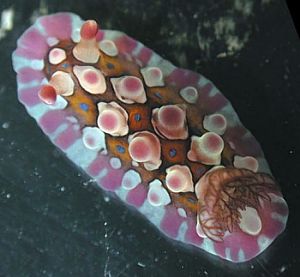
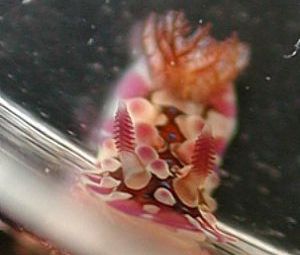
Hi Bill,
This I think this is a juvenile Dendrodoris denisoni. It was found crawling on intertidal seagrass on Fisherman Island. This island sits near the mouth of the Brisbane river in Moreton Bay, Queensland, so it is safe to say this species is silt tolerant! It was about 10mm long.
Nerida Wilson
nwilson@marine.uq.edu.au
Wilson, N., 2001 (Jun 8) Juvenile Dendrodoris denisoni from Queensland. [Message in] Sea Slug Forum. Australian Museum, Sydney. Available from http://www.seaslugforum.net/find/4503Dear Nerida,
Yes this is Dendrodoris denisoni. They are often much more spectacularly coloured as juveniles.
Best wishes,
Bill Rudman
Dendrodoris denisoni from Port Stephens
August 19, 2000
From: Stuart Hutchison
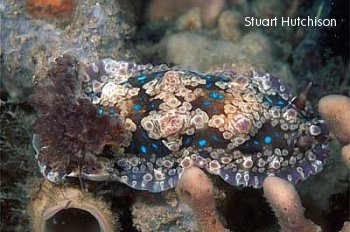
Dear Bill,
Here are some shots of Dendrodoris denisoni. From Fly Point (Nelson Bay, Port Stephens - NSW, Australia) in Dec 1998.
Depth 10m,
Size 70mm and 20mm (juvenile - bottom left).
Regards,
Stuart
hutchco@tpg.com.au
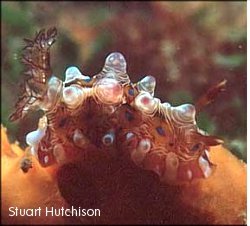
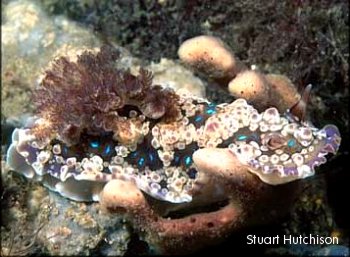
Thanks Stuart,
Bill Rudman.
Dendrodoris denisoni or D. gunnamatta
June 22, 2000
From: P.Zylstra & H.Rothenfluh
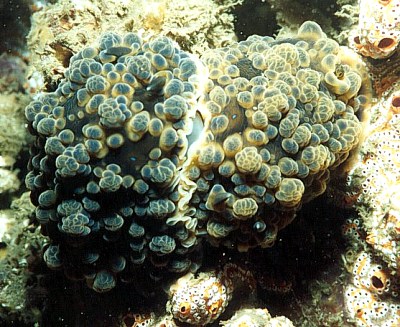
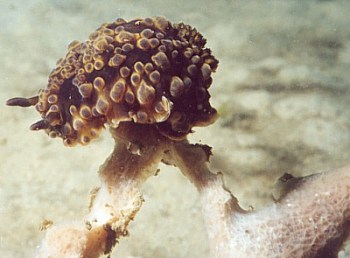
Hi,
We saw quite a few of these nudis at Clifton Gardens Wharf in Sydney on 13 May 2000 in 3-7m water [New South Wales, Australia]. They were crawling on the silt, sponges and pylons. We found a pair mating on a pylon during the day -- they were still there when we came back at night and took a photo.
Are these Dendrodoris denisoni? We thought they might be the darker form D. gunnamatta that you described.
Cheers
Paula Zylstra
Harry Rothenfluh
hsrpz@netspeed.com.au
Zylstra,P. & Rothenfluh,H., 2000 (Jun 22) Dendrodoris denisoni or D. gunnamatta. [Message in] Sea Slug Forum. Australian Museum, Sydney. Available from http://www.seaslugforum.net/find/2588Dear Paula & Harry,
Thanks for the second photo today of an animal almost certainly feeding. It looks to me that in the top photo there is a very fresh 'bite' in the sponge. And in the lower photo they are definitely mating.
For those of you not familiar with the ways of nudibranchs, they are hermaphrodite which means they all have a full set of male and female reproductive organs. They reproductive openings are situated somewhere on the right side of the body, so if you see two animals with their right sides very close together, or attached, then you can be sure they are mating.
Now, is this Dendrodoris denisoni of Dendrodoris gunnamatta? It is certainly the animal that was named Dendrodoris gunnamatta, but as I discuss at the top of the page, I think that it is probably a colour form of the more brightly coloured Dendrodoris denisoni but it is a bit hard to prove either way. See Stephanie Clark's photo below. One good character we can often use to distinguish species of nudibranch from one another, is the shape of their radular teeth. Unfortunately species of Dendrodoris are suctorial feeders which have lost their teeth, so we can't use that character. One feature all the 'colour forms' of D. denisoni have in common are the bright blue spots on their mantle. You can clearly see them in the photo of the mating animals.
There don't seem to be any clear anatomical features to separate one colour form from another so it seems to me that one way we could help solve the problem of how many blue-spotted species there are is to get some information on what they eat, how big their eggs are, and the shape and colour of their egg ribbons. You have helped with a photo of one possible sponge food. What we need is some photos of their egg ribbons and more of them feeding. If we can find some differences in egg size and colour then it may be worth while looking more closely for anatomical differences. It may take a while to get this information but it's worth a go.
Best wishes,
Bill Rudman.
Dendrodoris denisoni from South Africa
April 19, 2000
From: Valda Fraser
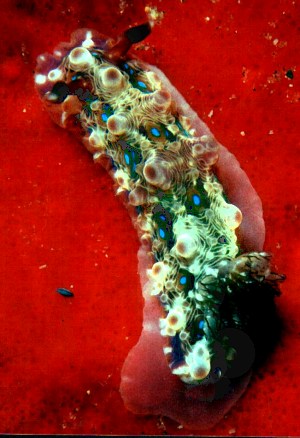
Dear Bill
I read in Debelius' book that Dendrodoris denisoni favours cold water. I have seen this nudibranch in warm water i.e. 22 degrees Celsius. ???? !!!!
Perhaps you could comment.
Locality: South coast KwaZulu-Natal SOUTH AFRICA. Hibberdene - 20m
Date: Oct 1999
Size: 35mm
Regards
Valda Fraser.
iti04937@mweb.co.za
Fraser, V., 2000 (Apr 19) Dendrodoris denisoni from South Africa. [Message in] Sea Slug Forum. Australian Museum, Sydney. Available from http://www.seaslugforum.net/find/2291Dear Valda,
To quote the English poet Pope: "a little learning is a dangerous thing ..". I am afraid Debelius doesn't give us references for his statements, so there is no way of checking them.
If you look at my page on Dendrodoris denisoni you will see that there is either one species or a complex of similarly coloured species throughout the tropical and temperate Indo-West Pacific. The earliest name, Dendrodoris denisoni, refers to a fairly drab coloured form usually found in estuaries in eastern Australia. The colourful form you have sent a photo of is certainly common in tropical waters. I have found it in very warm (tepid) water in Tanzania, and it was described by Alder & Hancock (1864) from India which is hardly 'cool waters.' We have photos here in the Forum of the form he illustrates from New Zealand, which used to be known as Dendrodoris mammosa.
At this stage I am treating them all as one species but I can't emphasise enough how important it is that we keep an open mind on identifications. To me, the sign of a good scientist and taxonomist is that they are not afraid to say 'I am not sure' or 'I don't know'. Such answers may be infuriating if you are trying to label your photographs, but they are a better reflection on the state of our knowledge. They also leave us with the exciting possibility that we can make new discoveries.
Best wishes,
Bill Rudman.
Dendrodoris denisoni from Sydney
January 3, 2000
From: Stephanie Clark
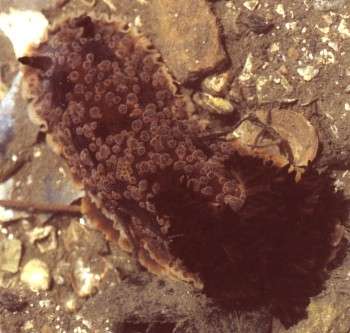
Dear Bill
This specimen of Dendrodoris denisoni was about 110mm and was one of about 70+ specimens seen around Rodd Island in Iron Cove, Sydney Harbour on the 22 Nov 1999. A large number of the individuals sighted were next to and / or laying egg strings. These were orange and consisted of hundreds of very small eggs. At the same time about 50+ specimens of Dendrodoris fumata were also found around the island. However, I did not not see any of them laying eggs.
The other species of nudibranch present at the time was two small clusters (about 10 individuals) of Noumea haliclona (no photos) on or next to there food a yellow sponge (Darwinella sp). The clusters mostly consisted of juveniles with a few scattered adults, nothing bigger than 10mm. Also found was one Aplysia extraordinaria.
Stephanie
inverte@internet-australia.com
Clark, S., 2000 (Jan 3) Dendrodoris denisoni from Sydney. [Message in] Sea Slug Forum. Australian Museum, Sydney. Available from http://www.seaslugforum.net/find/1711Dear Steph,
Thanks for the photo. This colour form of D. denisoni is quite common in estuaries and large harbours in south eastern Australia. I have not seen this colour form on the open coast.
Best wishes,
Bill Rudman.
Dendrodoris denisoni from New Zealand
December 13, 1998
From: Ross Armstrong
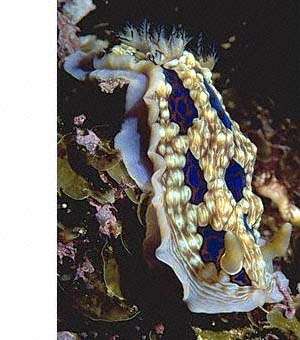
Bill,
Here is a photo of Dendrodoris gemmacea from the Poor Knights Islands in northeastern New Zealand. Photo: Diane Armstrong.
Ross Armstrong
ross@northpower.co.nz
Armstrong, R., 1998 (Dec 13) Dendrodoris denisoni from New Zealand. [Message in] Sea Slug Forum. Australian Museum, Sydney. Available from http://www.seaslugforum.net/find/386Dear Ross,
Thanks for the picture. I am pretty sure that the the New Zealand species is the same as the tropical Indo-West Pacific species and so its name should be Dendrodoris denisoni rather than Dendrodoris gemmacea. An interesting situation would arise if the New Zealand species does prove to be distinct. If so, the name Dendrodoris gemmacea would be incorrect because it was given to a species from India, which is almost certainly the tropical Indo-West Pacific species, and certainly not the New Zealand one. Probably the earliest name for the New Zealand one is Doridopsis mammosa Abraham, 1877. But that could also be debatable because it was given to a decolourised specimen in the British Museum by Abraham, who felt it was his "duty" to name all the unlabelled decolourised specimens in the British Museum. To overcome the almost impossible task of actually identifying them with living material, he named them all as new species, so leaving us a legacy of problems which are still unresolved!
Bill Rudman.
